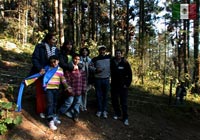
Sierra Chincua - Monarch Butterfly Sanctuary
Angangueo, Estado de Michoacán, México
December 20, 2004 - 15:10 Local Time
© 2004 Roberto Gómez Torres, All Rights Reserved.
Every fall, huge numbers of Monarch Butterflies gather in southern Canada to migrate. Until recently, it was not known where these butterflies went. We now know that some Monarch Butterflies travel over 3,100 kilometers, just to overwinter in places like Michoacan, Mexico. More specifically, these butterflies usually congregate in a small town in Michoacan called Angangueo. Some other Monarch Butterflies winter in Cuba or California. These long flights pose great danger for the butterflies, especially from predators.
In sanctuary in Angangueo, Michoacan in Mexico, the are thousands, or even millions, of Monarch Butterflies. From morning until about 1:00pm, you can see them flying around and almost obscuring the sky. You will hear the fascinating sound of their wings flapping.
Here, at altitudes of 9,000 to 12,000 feet, they overwinter, roosting in oyamel trees at night in groups estimated to be hundreds of thousands strong per tree. In the warmth of the morning sun, they fly low, landing to drink the morning dew and dampened earth near natural springs.
On the panorama, just behind me (the guy with the black jacket and blue jeans) you can see on the trees the clouds of butterflies set at the branches forming big orange spots all over the forest. Sadly the low resolution of my camera and the distance allowed for tourists can not revel more detail. But this is a place you should visit to appreciate at all its beauty.
Hope you like this beautiful Sanctuary.
Lat: 19° 36' 32" N
Long: 101° 18' 42" W
Elevation: 3,600m
Precision is: High. Pinpoints the exact spot.
Es también altamente resistente a las condiciones variables del tiempo, a título de comparación, podemos decir que las mariposas convencionales tienen un ciclo vital de 24 días, mientras que la mariposa monarca llega a vivir 9 meses; es decir, 12 veces más que las otras.
Proveniente de Norteamérica, llega a Zitácuaro, Ocampo y Angangueo, Municipios de Michoacán limítrofes con el Estado de México. La llegada de millones de mariposas ocurre a fines de octubre y su regreso a mediados de abril.
Actualmente, esta mariposa realiza un impresionante y largo viaje de más de 4,000 kilómetros, se alimentan en el camino de [asclepias], plantas llamadas lengua de vaca o "algodoncillo", que contienen un alcalóide venenoso para otras especies, pero que para la monarca significa protección; ya que al asimilar los venenos cardíacos producidos por dicha planta, le da un sabor y olor desagradable para los depredadores, así como también la provee de pigmentos colorantes, a su vez, la [asclepia] se beneficia con la monarca, debido a la polinización que ésta efectúa en una extensa zona.
Por muchos años se pensó que la mariposa monarca pasaba el invierno en zonas tropicales y subtropicales; pero...¿ Dónde ?. Fue un misterio hasta 1975, en que después de décadas de búsqueda se encontró su lugar de hibernación y para sorpresa de muchos estaba en una zona donde las temperaturas normales están cerca de los cero grados centígrados en una región boscosa con arboles como el oyamel, entre valles y montañas con una altitud promedio de 3,300 metros sobre el nivel del mar, en la majestuosa Sierra Madre.


 Tap or click the zoom icon in the bottom right corner of the picture to switch between in-page and fullscreen view
Tap or click the zoom icon in the bottom right corner of the picture to switch between in-page and fullscreen view